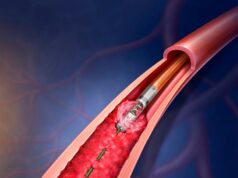 A research letter published in Circulation: Cardiovascular Quality and Outcomes highlights a “very low” utilisation of supervised exercise therapy (SET) in symptomatic peripheral arterial disease (PAD) patients during the first 19 months after approval by the Centers for Medicare & Medicaid Services (CMS) despite a Class IA guideline endorsement. First author Sanjay Divakaran (Brigham and Women’s Hospital, Boston, USA), senior author Eric Secemsky (Beth Israel Deaconess Medical Center, Boston, USA), and colleagues write that greater effort is needed to increase SET enrolment across the USA, as well as to improve adherence once enrolled.
A research letter published in Circulation: Cardiovascular Quality and Outcomes highlights a “very low” utilisation of supervised exercise therapy (SET) in symptomatic peripheral arterial disease (PAD) patients during the first 19 months after approval by the Centers for Medicare & Medicaid Services (CMS) despite a Class IA guideline endorsement. First author Sanjay Divakaran (Brigham and Women’s Hospital, Boston, USA), senior author Eric Secemsky (Beth Israel Deaconess Medical Center, Boston, USA), and colleagues write that greater effort is needed to increase SET enrolment across the USA, as well as to improve adherence once enrolled.
In addition to low utilisation of SET and limited participation in therapy following enrolment, the researchers also found that patients referred to SET differed in race, sex, socioeconomic status, and geographic region compared with those unenrolled, suggesting disparities emerging early during implementation.
Divakaran et al detail that SET is recommended in consensus guidelines, based on its proven ability to reduce symptoms of PAD and improve walking performance. A lack of reimbursement for SET was a barrier to access and utilisation up until May 2017, when the CMS determined that that the evidence was sufficient to cover SET for beneficiaries with intermittent claudication. The present study aimed to address a lack of data on utilisation and outcomes associated with SET since the introduction of reimbursement.
The research team included in their study patients with a Current Procedural Terminology code for SET or International Classification of Diseases, Tenth Revision Clinical Modification code for intermittent claudication required by CMS for SET reimbursement between 1 June 2017 (corresponding with CMS’ reimbursement agreement) and 31 December 2018.
Among 129,699 patients with a diagnosis of intermittent claudication, 1,735 (1.3%) were enrolled in SET during the study period, the authors relay in their research letter. The investigators further detail that the median number of SET sessions attended was 16 (interquartile range [IQR], 6–28), and that only 89 patients (5.1%) completed the programme, attending all 36 sessions.
Writing in Circulation: Cardiovascular Quality and Outcomes, the authors report that one-year cumulative incidence of endovascular and surgical revascularisation among patients participating in SET were 11.9% and 2.4%, respectively, adding that no patients undergoing SET underwent amputation during the follow-up period.
Divakaran et al further relay that, in a matched cohort analysis (n=6,940), the use of endovascular or surgical revascularisation was significantly lower among those who underwent SET—endovascular: hazard ratio (HR), 0.49 (95% confidence interval [CI], 0.4–0.6), p<0.001; surgical: HR, 0.27 (95% CI, 0.18–0.42), p<0.001. The researchers add that there were no other differences in outcomes between groups.
Addressing some limitations of their study, Divakaran and colleagues recognise that only a small number of patients were referred to SET and that follow-up time was short. In addition, they acknowledge the possibility of treatment selection bias and residual confounding, the inability to assess severity of symptoms due to the use of claims codes, and the lack of detail regarding SET protocols.













